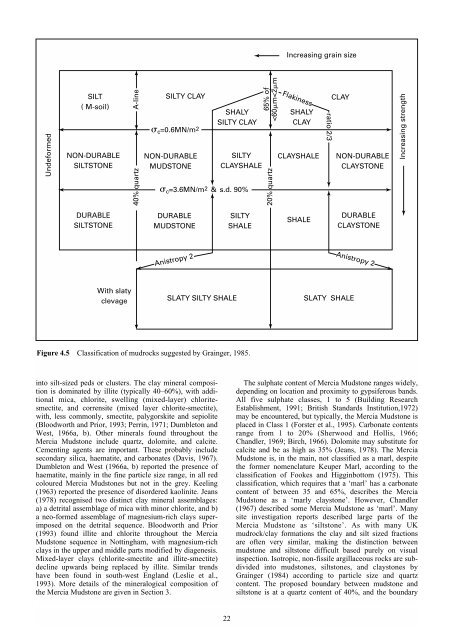Engineering geology of British rocks and soils Mudstones of the ...
Engineering geology of British rocks and soils Mudstones of the ...
Engineering geology of British rocks and soils Mudstones of the ...
Create successful ePaper yourself
Turn your PDF publications into a flip-book with our unique Google optimized e-Paper software.
Undeformed<br />
SILT<br />
( M-soil)<br />
NON-DURABLE<br />
SILTSTONE<br />
DURABLE<br />
SILTSTONE<br />
A-line<br />
40% quartz<br />
into silt-sized peds or clusters. The clay mineral composition<br />
is dominated by illite (typically 40–60%), with additional<br />
mica, chlorite, swelling (mixed-layer) chloritesmectite,<br />
<strong>and</strong> corrensite (mixed layer chlorite-smectite),<br />
with, less commonly, smectite, palygorskite <strong>and</strong> sepiolite<br />
(Bloodworth <strong>and</strong> Prior, 1993; Perrin, 1971; Dumbleton <strong>and</strong><br />
West, 1966a, b). O<strong>the</strong>r minerals found throughout <strong>the</strong><br />
Mercia Mudstone include quartz, dolomite, <strong>and</strong> calcite.<br />
Cementing agents are important. These probably include<br />
secondary silica, haematite, <strong>and</strong> carbonates (Davis, 1967).<br />
Dumbleton <strong>and</strong> West (1966a, b) reported <strong>the</strong> presence <strong>of</strong><br />
haematite, mainly in <strong>the</strong> fine particle size range, in all red<br />
coloured Mercia <strong>Mudstones</strong> but not in <strong>the</strong> grey. Keeling<br />
(1963) reported <strong>the</strong> presence <strong>of</strong> disordered kaolinite. Jeans<br />
(1978) recognised two distinct clay mineral assemblages:<br />
a) a detrital assemblage <strong>of</strong> mica with minor chlorite, <strong>and</strong> b)<br />
a neo-formed assemblage <strong>of</strong> magnesium-rich clays superimposed<br />
on <strong>the</strong> detrital sequence. Bloodworth <strong>and</strong> Prior<br />
(1993) found illite <strong>and</strong> chlorite throughout <strong>the</strong> Mercia<br />
Mudstone sequence in Nottingham, with magnesium-rich<br />
clays in <strong>the</strong> upper <strong>and</strong> middle parts modified by diagenesis.<br />
Mixed-layer clays (chlorite-smectite <strong>and</strong> illite-smectite)<br />
decline upwards being replaced by illite. Similar trends<br />
have been found in south-west Engl<strong>and</strong> (Leslie et al.,<br />
1993). More details <strong>of</strong> <strong>the</strong> mineralogical composition <strong>of</strong><br />
<strong>the</strong> Mercia Mudstone are given in Section 3.<br />
22<br />
Increasing grain size<br />
SILTY CLAY CLAY<br />
c=0.6MN/m2<br />
NON-DURABLE<br />
MUDSTONE<br />
SHALY<br />
SILTY CLAY<br />
SILTY<br />
CLAYSHALE<br />
c=3.6MN/m2 & s.d. 90%<br />
DURABLE<br />
MUDSTONE<br />
Anistropy 2<br />
SILTY<br />
SHALE<br />
SHALY<br />
CLAY<br />
CLAYSHALE NON-DURABLE<br />
CLAYSTONE<br />
SHALE<br />
With slaty<br />
clevage SLATY SILTY SHALE SLATY SHALE<br />
Figure 4.5 Classification <strong>of</strong> mud<strong>rocks</strong> suggested by Grainger, 1985.<br />
65% <strong>of</strong><br />

















